
Back in September 2017 I wrote an article about photography, considering whether or not it could truly be considered an art form. I was being a little disingenuous, many people make a living from taking photographs. Photography exhibitions, especially where wildlife and other aspects of nature are concerned, are extremely well attended by just as many people who are there to admire the aesthetics of the pictures as are there to marvel at the skills of the photographers. Huge financial rewards and highly lucrative careers can result from the single photograph that some professional photographers call “The Money Shot”.
In the intervening period since that article was published I’ve continued to take photographs and I’ve started to experiment with editing techniques. For a dyed in the wool technophobe like me that’s been a bit of a challenge, but the “suite” that the manufacturer of my camera provides to all owners has become an invaluable tool. I’m not one for attempting to over enhance the quality of all the pictures that I take, but some photographs, especially those of nature, wildlife and landscape, can benefit from subtle colour highlighting and the use of either or both of the brightness and contrast sliders. Some people I know experiment much more and can produce some stunning effects, but that isn’t really what my admittedly amateur efforts are about.
DSLR (Digital Single Lens Reflex) cameras and, increasingly, cameras contained within high technology smart phones have opened up the world of photography to many people, with often stunning results. There are some purists, including an albeit decreasing number who still use film, that don’t consider digital photography to be a true expression of the art of photography itself and, to a certain extent, I get where they’re coming from. However, there’s far more to using a DSLR and getting real satisfaction from the results than setting the camera/phone to one of the pre-set auto functions, pointing and shooting.
The last time I wrote about this topic I wasn’t fully “au fait” with many of the technical aspects of photography and I’m still nothing more than an enthusiastic amateur with much to learn but, having attended a couple of workshops, I’ve come to realise that there are many elements to taking a decent photograph. With a bit of good fortune and the correct usage of both camera & suitable support system (tripod, beanbag, tree stump, boulder, conveniently placed wall, steady hand) and always remembering that any art form is subjective when coming to judge it, decent photographic opportunities, when combined with technique, skill and a good deal of luck can produce excellent results.
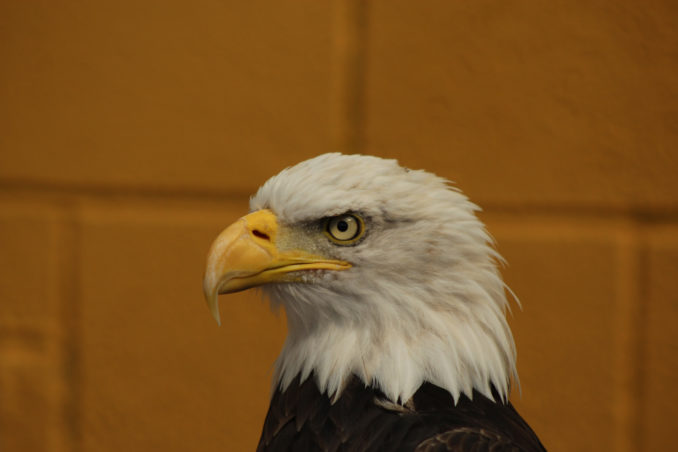
Manual Camera Setting. F Stop 5.0. S/S 1/1600. ISO 200. 18-55mm lens © Colin Cross, Going Postal 2020
The featured image is a crop of the eye from this shot
This eagle was sitting quietly on its perch. A convenient wall gave added stability to my bean bag attachment, allowing me to take time to adjust the focal length and ensure that eye, nostril and beak tip were all in focus utilising the AF (Automatic or multi-point focus function). The editing suite on my desk top was used to confirm that all focus points were as I’d hoped. I haven’t enhanced the photograph in any way. The background wall is left deliberately out of focus, which draws the eyes to the subject.

Manual Camera Setting. F Stop 5.6. S/S 1/500. ISO 1600. 18-55mm lens © Colin Cross, Going Postal 2020
Out with the camera club one Friday, when we were taking pictures of rock formations in an abandoned quarry, I came across this emerging toadstool. I assumed it hadn’t long been exposed to the air. My first thought was to brush away the soil but that would have been to deny the “spontaneity” of the image. I used my tripod and the timer function (set to 10 seconds) on the camera to ensure stability. The light wasn’t great but automatic ISO does a job when that’s the case. I made the darker yellow patch the point of focus, pressed the shutter, stepped back and waited. This image hasn’t been enhanced in any way.

Manual Camera Setting. F Stop 5.0. S/S 1/20 ISO 100. 18-55mm lens © Colin Cross, Going Postal 2020
The camera club tries to vary venue and subject as much as possible, fortunately Cumbria offers plenty of choice. In June of last year we visited the 12th century church of St. Michael near Tirril. I took some shots inside the church before deciding to investigate the exterior. The handle on the main church door, the studs and the grain of the wood caught my attention as I left. I didn’t use a support system and gambled on a slow shutter speed as the light wasn’t too great. My hand must have been pretty steady. I don’t think the door is as old as the church but I’d say it’s been there a year or two.

Manual Camera Setting. F Stop 8.0. S/S 1/20. ISO 1250. 18-55mm lens © Colin Cross, Going Postal 2020
This Bren Gun was sat on top of a jeep at a Second World War event held at Brougham Castle in May 2019. I initially took a picture of the whole jeep but I was struck by the patina on the stock and the ammo clip. The mudguard of a truck offered me a stable base to get the shot. I’ve cropped it very slightly as I wanted to maintain the focus on the weapon. the higher F Stop number coupled with slowish shutter speed allowed me to keep the rifle and ammo boxes in pretty sharp focus.

Manual Camera Setting. F Stop 8.0 S/S 1/640. ISO 160. 18-55mm lens © Colin Cross, Going Postal 2020
Walking up “Crag Lonin'” on a lovely sunny day in December I was struck by how the light was catching this stalk of dead cow parsley. I hadn’t intended for the fronds nearest the camera to be the only ones in focus but I like the result. It probably came about because I used a relatively fast shutter speed as I was relying on the steadiness of my hand. I have cropped this picture slightly but the colours are “as shot”. One of those occasions when the luck was with me.
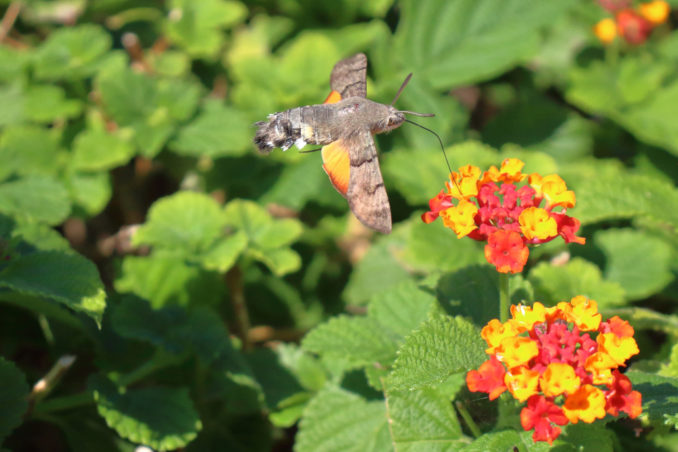
Manual Camera Setting. F Stop 5.6 S/S 1/4000 ISO 800. 18-55mm lens © Colin Cross, Going Postal 2020
I consider this to be one of my best efforts. It came out exactly as I planned it to. I did have the camera function set on continuous shooting but I actually only shot six frames, all in 3/2000ths of a second. I didn’t fully expect to catch the tongue of the moth, or the wings, in such sharp focus. The sun was above and behind me and the light (this was taken on Zakynthos) was perfect, allowing the colours of the flowers to really stand out even though all the focus was on the moth. A very fast shutter speed is essential for shots like this. In poor light it may not have been possible to take this picture but the F number would have needed to be much higher to have any chance at all.
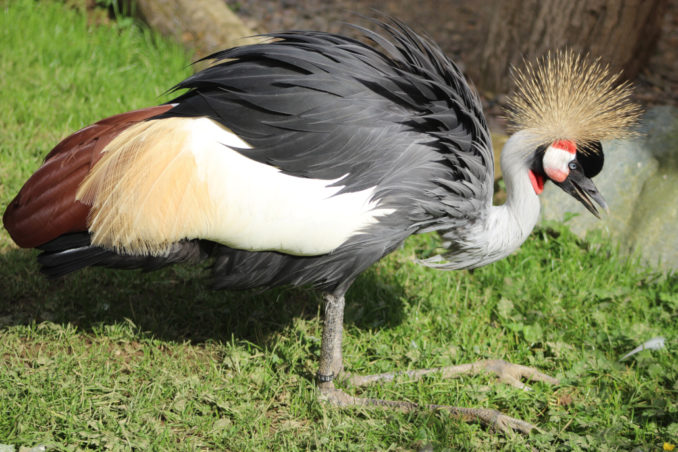
Manual Camera Setting. F Stop 4.5. S/S 1/500. ISO 100. 18-55mm lens © Colin Cross, Going Postal 2020
This picture was taken at The Lake District Wildlife Park near Bassenthwaite. Fortunately the bird, one of a pair, seemed to be both used to humans and also at some form of rest. It hardly moved as I set up the shot. When I got home and uploaded it to the desk top I was pleasantly surprised at the definition of the plumage right across the photograph. I have cropped it slightly to remove distractions but the key here is the eye. It’s in “pin sharp” focus which isn’t always easy to achieve, especially when there are multiple points of focus across a picture. This was in a quite shaded area, so I upped the brightness a notch, otherwise it isn’t enhanced.

Manual Camera Setting. F Stop 6.3. S/S 1/1600. ISO 320. 18-55mm lens © Colin Cross, Going Postal 2020
What’s really striking about this photograph, apart from the focus quality, is the strength of the colours. I was lucky again with the light, the sun was behind my left shoulder. The bee was too busy to take much notice of what I was doing so I took one shot and checked it on the camera screen. The full impact only came through when I uploaded it to the desk top. I have enhanced the yellows a couple of notches and cropped it slightly but the overall effect of the “raw” image isn’t detracted from, in my opinion.
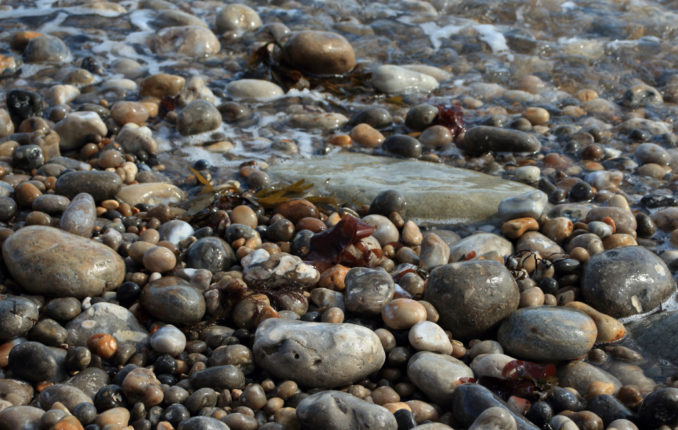
Manual Camera Setting. F Stop 6.3. S/S 1/250. ISO 200. 18-55mm lens © Colin Cross, Going Postal 2020
The focus in this photograph is particularly good. I laid flat on the beach and used a largish stone to provide support for my trusty bean bag, waited for the sea to flow over the pebbles, then retreat. I’ve cropped the picture very slightly, but the colours, brightness and contrast are “as shot”. I particularly like the shine created by the receding water, this was partly facilitated by employing a relatively slow shutter speed . A particular favourite.
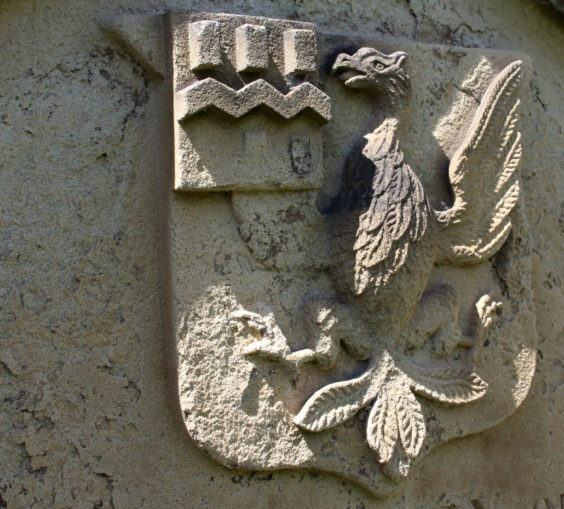
Manual Camera Setting. F Stop 9.0. S/S 1/640. ISO 640. 18-55mm lens © Colin Cross, Going Postal 2020
This carving, on a very old gravestone in Barton Church graveyard, is no larger than 6 inches by 6 inches. I took the picture as I was intrigued by the skill of the stone carver and the weathered quality of the stone. This isn’t an added plaque, it’s an integral part of the headstone. I took the shot from several angles as I wanted to eliminate the shadow but the “front on” image wasn’t detailed enough. You win some, you lose some. I promised myself I’d research the crest, but I haven’t got around to it yet.
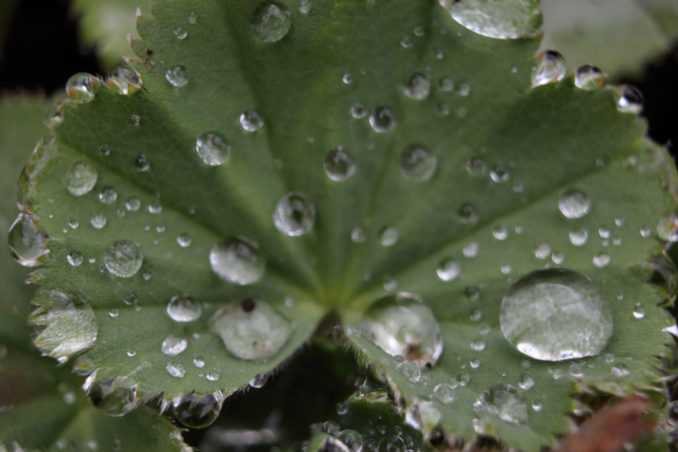
18-55mm lens © Colin Cross, Going Postal 2020
I could go on, as I’ve got more interested in the results I’ve continued to experiment with camera angles, use of light, shutter speeds and F Stop numbers. Essentially though I enjoy the “randomness” of photography. Often the best pictures aren’t the ones you set out to take, but the opportunistic ones that you come across. I spent a good few minutes setting this one up, only to be very disappointed with the finished effort. So much so that I deleted the “raw” file and have no idea what settings I used!
Key to Terminology
DSLR; Digital Single Lens Reflex camera
F Stop; The F Stop relates to the size of the aperture in the lens of a camera related to the focal length. If you had a zoom set at 40mm with an aperture of f/8, the diameter of the aperture opening would be 5mm (40 divided by 8). It determines the amount of light entering the camera when a photograph is taken.
S/S; Shutter speed is simply the speed at which the shutter opens and closes. Generally, the faster the shutter speed, the higher the F number required to optomise the light.
ISO; ISO is a settable function (I always set to auto) that amplifies the light signal generated by the combination of F Stop and shutter speed.
AF; The AF Point Selection allows the camera to indicate when any number of points within the target are in focus, setting this to Manual allows the photographer to select one single point of focus.
MANUAL; Selecting the Manual setting on the function wheel allows more control over the finished results. Generally the best way of getting a “feel” for a camera.
RAW; A settable function on any DSLR which allows greater control over any editing, images taken in RAW can easily be converted to J Peg. All above images are converted from RAW.
NB; This information relates primarily to the Canon “D” range of cameras. Other makes will have broadly the same functions.
Every DSLR will have one or more Auto Picture taking settings on the main function wheel. Using these will allow the camera to take the picture it wants to take, rather than the picture you might want it to take, the result may not be as good as you hoped it might. Taking pictures in Manual setting, which allows the setting of focal length, shutter speed and F Stop generally means better results. The camera will indicate when you are close to optimum focus (usually this is a simple line graph on the camera screen) allowing you to experiment but also be more “in charge” of the finished photograph.
© Colin Cross 2020
The Goodnight Vienna Audio file



